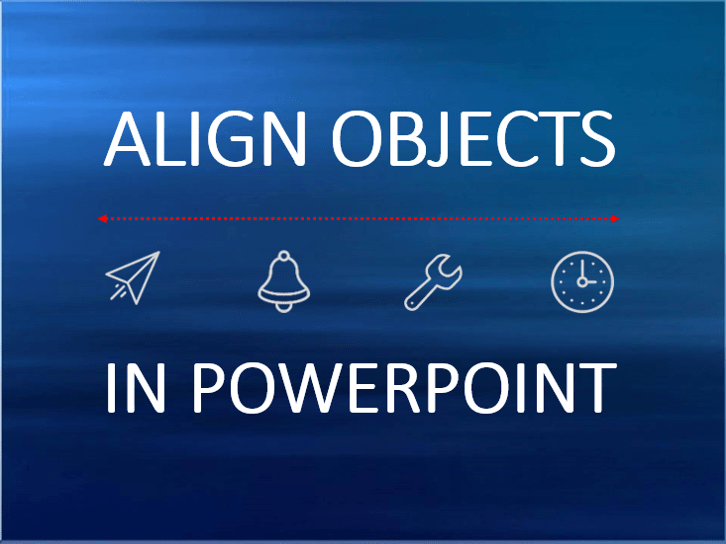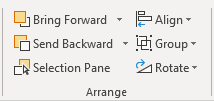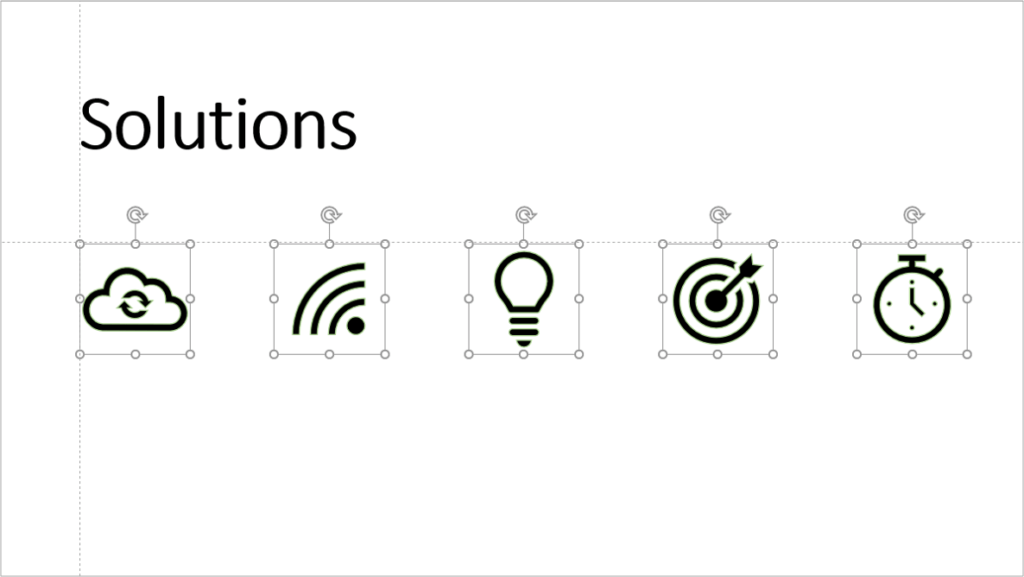Align Shapes, Images and Other Objects in PowerPoint
by Avantix Learning Team | Updated August 24, 2023
Applies to: Microsoft® PowerPoint® 2013, 2016, 2019, 2021 and 365 (Windows)
You can align objects in PowerPoint in several ways. Objects you align may be shapes, images, placeholders or text boxes. However, you can also align charts, tables and SmartArt objects. The most common way to align objects is to use the Align command which appears on multiple tabs in the Ribbon.
Note: Buttons and Ribbon tabs may display in a different way (with or without text) depending on your version of PowerPoint, the size of your screen and your Control Panel settings. For PowerPoint 365 users, Ribbon tabs may appear with different names. For example, the Picture Tools Format tab may appear as Picture Format and the Drawing Tools Format tab may appear as Drawing Format or Shape Format.
In this article, we'll review several ways to align objects:
- Align objects using the Align command in the Ribbon
- Align an object or objects to the slide
- Align objects using guides
- Align and copy objects using shortcuts
Recommended article: How to Reduce PowerPoint File Size (10 Ways to Compress PowerPoint Decks)
Do you want to learn more about PowerPoint? Check out our virtual classroom or live classroom PowerPoint courses >
1. Align objects using the Align command in the Ribbon
You can use the Align command in the Ribbon to align objects. Align appears on several different tabs.
Below is the Align command in PowerPoint 365 on the Format tab in the Ribbon:
To align objects using the Align command in the Ribbon:
- Select the objects by clicking the first object and then pressing Shift or Ctrl and clicking on the other objects. If you are selecting a text box or placeholder, Shift or Ctrl-click its edge. You can also select multiple objects by clicking in a blank area and dragging around them.
- Click the Format tab in the Ribbon. Alternatively, you can also click the Home tab.
- In the Arrange group, click Align. A drop-down menu appears. Align selected objects should be selected. If it is not selected, choose Align selected objects and then click Align again.
- Select Align Left, Align Center, Align Right, Align Top, Align Middle or Align Bottom.
The alignment options align selected objects as follows:
- Align Left aligns objects along their left edges
- Align Center aligns objects vertically through their centers
- Align Right aligns objects along their right edges
- Align Top aligns objects along their top edges
- Align Middle aligns objects horizontally through their middles
- Align Bottom aligns objects along their bottom edges
Note: Align is not available when you right-click and display the context or drop-down menu.
You can right-click Align in the Ribbon and select Add to Quick Access Toolbar from the drop-down menu to add it to the Quick Access Toolbar (which appears above or below the Ribbon).
In the following example, the objects in the middle of the slide have been aligned by their top edges:
2. Align an object or objects to the slide
You can also align an object or objects to the slide.
To align an object or objects to the slide using the Align command in the Ribbon:
- Select the object or objects by clicking the first object and then pressing Shift or Ctrl and clicking on the other objects. If you are selecting a text box or placeholder, Shift or Ctrl-click its edge. You can also select multiple objects by clicking in a blank area and dragging around them.
- Click the Format tab in the Ribbon. Alternatively, you can also click the Home tab.
- In the Arrange group, click Align. A drop-down menu appears.
- Select Align to Slide if it is not selected.
- Click Align again.
- From the drop-down menu, select Align Left, Align Center, Align Right, Align Top, Align Middle or Align Bottom.
3. Align objects using guides
You can also display guides (static guides) and use them to align objects. Smart Guides may also appear when you drag objects.
To use guides to align objects:
- Right-click in a blank area of the slide.
- Select Grids and Guides from the drop-down menu.
- Select Guides from the sub-menu to show the guides. Note that these guides are different from gridlines or Smart Guides. PowerPoint displays a horizontal and vertical guide by default.
- Drag the guides to the desired location. You can also right-click a guide and add a new guide.
- Select each object and drag it to the guide to align it.
- Repeat for other objects.
- Right-click in a blank area of the slide.
- Select Grids and Guides from the drop-down menu.
- Select Guides from the sub-menu to hide the guides.
You can also show and hide guides using the View tab in the Ribbon.
In the example below, we've displayed guides and used them to align icons by their top edges (guides may be difficult to see because they are a light grey by default):
In PowerPoint 2013 and later versions, you can right-click a guide and change its color.
When an object is close to a guide, it will normally snap to the guide. Objects may also align to an invisible grid when you are moving them. To turn this off, check out How to Turn Off Snap to Grid in PowerPoint.
4. Align and copy objects using shortcuts
When you copy multiple objects, you can align them as well.
To copy an object and align it with the first object:
- Select an object. If the object is a text box or placeholder, click its edge.
- Press Ctrl and Shift and drag the object to a new location to make a copy. If you press Ctrl while you drag an object, PowerPoint makes a copy of the object. If you press Shift as well as Ctrl, the object will stay aligned with the previous object. Do not perform any other actions.
- Press Ctrl + Y to repeat. Another object will be created to the right or below the second object and aligned with the previous object.
- Continue pressing Ctrl + Y to make more copies of the object.
Use alignment to align PowerPoint objects and create well-designed slides. Unfortunately, there is not a built-in keyboard shortcut to align objects so consider adding Align to your Quick Access Toolbar.
Subscribe to get more articles like this one
Did you find this article helpful? If you would like to receive new articles, JOIN our email list.
More resources
How to Turn Off Automatic Text Resizing in PowerPoint
How to Group and Ungroup in PowerPoint (with Shortcuts)
How to Remove the Background of an Image in PowerPoint
How to Add Animation in PowerPoint (Animate Text, Images and Other Objects)
How to Change the Background of PowerPoint Slides to a Color, Gradient or Picture
Related courses
Microsoft PowerPoint: Intermediate / Advanced
Microsoft PowerPoint: Design for Non-Designers
Microsoft PowerPoint: Animations Bootcamp
Microsoft Excel: Intermediate / Advanced
Our instructor-led courses are delivered in virtual classroom format or at our downtown Toronto location at 18 King Street East, Suite 1400, Toronto, Ontario, Canada (some in-person classroom courses may also be delivered at an alternate downtown Toronto location). Contact us at info@avantixlearning.ca if you'd like to arrange custom instructor-led virtual classroom or onsite training on a date that's convenient for you.
Copyright 2024 Avantix® Learning
You may also like
How to Insert or Type E with an Accent Mark in PowerPoint (È, É, Ê, Ë, è, é, ê, or ë)
You can insert or type e with an accent mark in PowerPoint using built-in tools or keyboard shortcuts (including Alt code shortcuts). The letter e can be inserted with an accent in both upper or lower case in text boxes or placeholders on slides, the slide master or layouts. The following are common accents in upper or lower case – È, É, Ê, Ë, è, é, ê, or ë.
How to Fade a Picture or Part of a Picture in PowerPoint (Using a Gradient)
You can fade a picture in PowerPoint by drawing a rectangle shape on top of the picture and then filling the rectangle with a gradient from opaque to transparent. This technique is often used to fade an image into the background of a slide. Since the rectangle is placed on top of the image and then text may be placed on top of the rectangle, you may need to reorder the objects.
How to Lock an Image, Shape or Other Object in PowerPoint
You can now lock an image, shape or other object in PowerPoint. Objects can be locked in Normal View or Slide Master View. Only PowerPoint 365 users can lock objects to prevent moving and resizing. This is helpful if you want to select and move other objects on the slide or prevent others from moving or resizing an object. You can lock items using the context menu or the Selection Pane.
Microsoft, the Microsoft logo, Microsoft Office and related Microsoft applications and logos are registered trademarks of Microsoft Corporation in Canada, US and other countries. All other trademarks are the property of the registered owners.
Avantix Learning |18 King Street East, Suite 1400, Toronto, Ontario, Canada M5C 1C4 | Contact us at info@avantixlearning.ca










